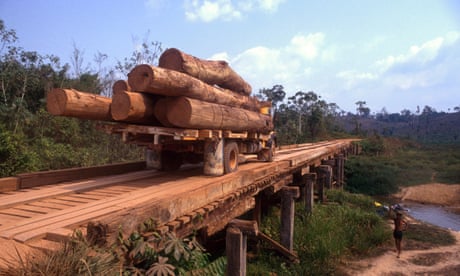- by foxnews
- 02 Feb 2025
Human activity and drought ‘degrading more than a third of Amazon rainforest’
Human activity and drought ‘degrading more than a third of Amazon rainforest’
- by theguardian
- 27 Jan 2023
- in news

Human activity and drought may have degraded more than a third of the Amazon rainforest, double the previous estimate, according to a study that heightens concerns that the globally important ecosystem is slipping towards a point of no return.
Fires, land conversion, logging and water shortages, have weakened the resilience of up to 2.5m sq km of the forest, an area 10 times the size of the UK. This area is now drier, more flammable and more vulnerable than before, prompting the authors to warn of "megafires" in the future.
Between 5.5% and 38% of what is left of the world's biggest tropical forest is also less able to regulate the climate, generate rainfall, store carbon, provide a habitat to other species, offer a livelihood to local people, and sustain itself as a viable ecosystem, the paper observes.
This degradation is on top of the 17% of the original forest that has been completely cleared over the past half century with Brazil having pushed back its agricultural and mining frontiers to satisfy the demands of an increasingly wealthy, more populous and high-consuming world.
"There is hope now, but our paper shows it is not enough to resolve deforestation. There is much more work to be done," said Jos Barlow, of Lancaster University.
The findings, published in Science on Thursday, are based on a review of existing studies, recent satellite data, and a new assessment of drought impacts by an international team of 35 scientists and researchers, from institutions including Brazil's University of Campinas (Unicamp), the Amazon Environmental Research Institute (IPAM), the National Institute for Space Research (INPE), and the UK's Lancaster University.
Water deprivation accounts for most of the increase in Amazon degradation compared with the previous estimate of 17%. Drought is an area of increasing concern because it raises the forest's vulnerability to fire and diminishes by up to 34% its ability to regenerate itself through evapotranspiration - the generation of rainclouds by trillions of plants.
This has knock-on effects across a wider region, including in food producing areas that depend on the Amazon's "flying rivers" to water crops. Most worryingly it raises the spectre of a destructive feedback loop in which drought makes the forest less able to pump water which leads to more drought.
To prevent these risks from spiralling out of control, the authors urge policymakers to reduce the drivers of degradation and treat it as much of a priority as the better-known problem of deforestation. The two vary greatly in terms of visibility. Deforestation is the total clearance of forest and conversion of the land to other uses, which can be easily identified by satellites. Degradation, on the other hand, is the partial loss of vegetation due to human behaviour, which is often hidden because it takes place under the canopy of bigger trees.
To the naked eye, the distinction is as great as that between having your hair shaved off completely and thinned. But degradation has at least as much of an impact as localised deforestation, as it affects a far larger area. The paper says the quantities of carbon released from degradation could even be higher than those from deforestation.
The authors acknowledge considerable uncertainty in their estimates because degradation is difficult to measure and define. This is reflected in the wide range of estimates for the affected area: from 5.5% of the remaining forest if only fire, logging and edge-effects are included, to 38% if drought effects are added.
The impacts on society are unevenly distributed. Most of the economic benefits from logging and land clearance are channelled to distant cities and other countries. By contrast, most of the negative impacts - loss of forest products, worsening air quality, deteriorating water quality - are suffered by indigenous and other forest communities.
Barlow warns of socio-economic tipping points when a forest becomes so degraded it is abandoned by local people, which means less protection against extractive industries.
The authors of the paper advise policymakers to step up monitoring of degradation, strengthen fire fighting capacity, curb logging, and plant buffer zones of secondary forests to protect the exposed borders of original vegetation.
- by foxnews
- descember 09, 2016
Disney reveals fate of closed Star Wars hotel
The building that was formerly home to the Star Wars: Galactic Starcruiser at Walt Disney World in Orlando, Florida will be repurposed, the company confirmed to local media earlier this week.
read more


